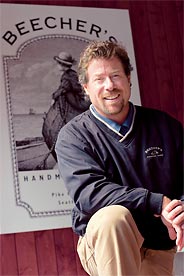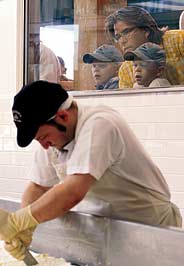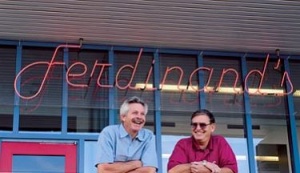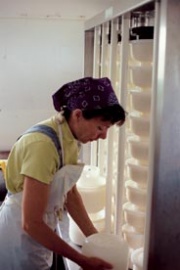Personal tools
Help
Class Notes
- Do you have news for fellow WSU alumni and other readers of Washington State Magazine? Send us your class note.
Our Story
written by alumni, faculty and friends.
NOTE: THIS IS A LEGACY SITE AND IS NOT REGULARLY MAINTAINED
Views
How Cougar Gold made the world a better place
From Our Story
by Tim Steury
From Washington State Magazine, Winter 2004/05
Kurt Dammeier ’82 is a cheese evangelist. He traces the roots of his passion and faith to discovering Cougar Gold during his days at Washington State University. In November, his Beecher’s Handmade Cheese celebrates a year of business at Seattle’s Pike Place Market with the release of its aged Flagship cheese, which is inspired by Cougar Gold.
Even though it is only seven months old, Dammeier gives me a slice and waits expectantly as I taste it. And yes, it reminds me of Cougar Gold. A cheddar style, but with a creamy finish rather than the normal sharp finish of a cheddar. But it is different. A little denser. A little creamier. It is fabulous.
Dammeier is pleased by my response, but not surprised. He knows how good it is.
The butterfat is higher than in Cougar Gold, he explains. The milk Beecher’s uses contains 3.9 percent butterfat. “We’d like to get to 4.2 percent.” Cougar Gold uses milk that contains 3.8 percent butterfat. This translates to about 35 percent butterfat in the cheese.
The milk that makes Cougar Gold comes from the University’s 135 Holstein cows. Beecher’s buys its milk exclusively from Cherry Valley, a small dairy farm outside of Duvall. Their cows are primarily Jersey and Brown Swiss, lovely breeds that have largely disappeared from American dairies, because even though they produce a higher-fat milk, they are not so prolific as the Holsteins. In order to boost the fat, Beecher’s itself bought an additional 40 Jerseys to add to the herd.
When he noticed one morning that Molbak’s garden store at Pike Place was closing, Dammeier suddenly realized what route his cheese quest would take. His initial foray had reached an apparent dead end. He recalls consulting with former WSU Creamery manager Marc Bates ’70, ’76 and an agricultural economist when he was still contemplating making a farmstead cheese.
“They thought I was really naïve,” says Dammeier. ”They tried to talk me out of it.”
What Bates and the economist had not considered was that Dammeier is, as he calls himself, a marketing guy.
Dammeier’s Sugar Mountain Capital owns Pasta & Co. and holds a major share of Pyramid Breweries.
“The usual problem,” he says, “is you know what you want to make, but don’t know how to sell it.
“I knew how to sell it. I didn’t know how to make it.”
So he hired Brad Sinko as his cheese maker. Sinko had been creating artisan cheeses for his family’s Bandon Cheese Company in Oregon until Tillamook bought it. Now at Beecher’s, Sinko makes the cheese. Dammeier sells it. They’re a great pair.
Beecher’s cheese is made on site, the production area enclosed by glass. “You can always tell when little kids have been here,” says Sinko, “because there’s lip and nose marks everywhere.”
Beecher’s makes and sells a number of cheeses other than the forthcoming Flagship and also features a small café, serving assorted cheese-based dishes, including what Dammeier calls the world’s best macaroni and cheese.
The store also sells cheese by a number of cheese makers throughout the Northwest. And it’s here, when talking about other people’s cheese, that Dammeier’s true evangelism shines.
“I’ll bet you on an average day there’s a hundred people enter our store who’ve never thought of cheese beyond the yellow Kroger-variety cheddar,” he says. However, you don’t convert people to premium cheese by providing them with something fuzzy and blue that stinks of a barnyard, no matter how exquisite that cheese might be to the gourmand.
Rather, you make it familiar. But better. People are comfortable with cheddar and jack and even the frenchy-sounding fromage blanc—which Beecher’s calls “blank slate.”
But give the people a familiar cheese that tastes like cheese should, and before you know it, they’re trying that fuzzy blue stuff. In other words, they’re buying more cheese. They’re buying more not only of Beecher’s cheese, but of the many regional farmstead and artisan cheeses that Beecher’s also sells. Dammeier sees his store as a way to both market small production cheeses and also build a market.
“The same thing happened in the early days of craft brewing,” he says. “It took a while for consumers to understand the value of a $7.99 six-pack versus a $4.99 six-pack and why it’s more flavorful, more authentic, more interesting.
“When you’re making things in small batches, it costs more.”
Dammeier ticks off the three tenets that underlie his approach to business. Full-flavored, great-tasting food. Fun and theatrical. Finally, he says, “Not a single thing produced by us has any additives, any preservatives. It’s pure, simple food.”
Along those lines, Dammeier announced in August that 1 percent of Beecher’s sales will go to a foundation dedicated to educating the public, especially children, about food production, how it is grown, processed, and transported, as well as what’s in it and what those ingredients mean to the health of the consumer and of the planet.
Not Your Average Cheddar
In the 1930s, Washington State College food scientists started research on packaging hard cheese in cans. Responding to a need for more canned foods during World War II, the U.S. government and American Can Company invested in the research in the 1940s. Cheese at the time was sealed in wax, as much still is. Wax can crack, allowing spoilage.
The main obstacle toward putting cheese in a can was the production of carbon dioxide by bacteria in the cheese, which caused the cans to bulge and even burst. Finally, N.S. Golding, a professor of dairy husbandry, discovered that adding a second starter culture to the cheese greatly reduced the carbon dioxide production. This second culture, known to us non-initiates simply as “WSU 19,” is what sets Cougar Gold apart.
This “adjunct culture” transforms a cheese that starts with a standard cheddar culture into the unique flavor and finish of Cougar Gold. Whereas cheddars generally have some bitter notes and finish on the palate with a sour milk sharpness, Cougar Gold finishes softer and creamier.
The texture is also different from most cheddars, more crumbly, largely due to its being aged for a year.
This uniqueness presents a certain difficulty in cheese competitions. Even though Cougar Gold is basically a cheddar in its youth, the texture, as well as its extra flavors, prohibits its entry in cheddar categories, which are quite specific in their criteria. Despite the categorical difficulty, though, Cougar Gold won the top of its class (hard pressed non-cheddar cheeses) in the World Cheese Awards in England in 2000.
Cougar Gold today is much the same cheese as it was when first produced in 1948. Of course the cows that produce the milk come and go, and their feed will vary over the years in nutritional makeup. A few years ago, the salt was reduced slightly. But the starters and recipe remain the same.
“We just try not to break it,” says Marc Bates, who was Creamery manager for 27 years and is now a consultant.
Although the Creamery also makes a traditional cheddar, a jack, and several flavored cheeses, Cougar Gold accounts for 75 percent of its sales. In fact, because of steadily increasing demand, the Creamery recently dropped a couple of its less popular varieties in order to increase Cougar Gold production. It has also started buying milk from a herd managed by the WSU student dairy club, CUDS (Cooperative University Dairy Students). In all, the Creamery produced last year 375,000 pounds of cheese, in 200,000 cans. Sixty percent of their cheese sells between October and Christmas. The campus store accounts for 20 to 25 percent of revenue. Most sales are by mail. The newest outlet is the Washington State Connections store in Seattle.
All that cheese requires someone to make it, of course. Including Salvadalena, the Creamery supports seven staff positions, a full-time faculty member and a staff member in Food Sciences and Human Nutrition, two research graduate assistants, and part-time work for 50 students. Many people working in the dairy and cheese industry today got their cheese education at the Creamery.
The Creamery’s cheese-making education is not restricted to undergraduates. For the past 20 years, WSU has offered an annual four-day cheese-making course. The bulk of the class entails lectures by cheese experts from around the country. But one day is devoted to hands-on cheese making. This year, the class made gouda, havarti, mozzarella, cheddar, feta, cottage cheese, queso fresco, and ricotta.
Beecher’s Sinko, who took the class in 1993 (Dammeier has also taken it), calls the course “way, way, way better” than any of the others offered around the country. Class size is limited to 27 students. This year, says Salvadalena, they didn’t even have to advertise. They simply called up everyone on the waiting list and filled the class.
The makeup of the class has changed significantly over the years, says Salvadalena. Originally, students were primarily from big cheese making plants such as Tillamook and Darigold. “Now more than half are farmstead.”
“Farmstead” describes small-scale cheese makers who make cheese from their own animals rather than buying their milk.
After 20 years, the influence of the cheese making class has spread around the country. Students this year came from Vermont, British Columbia, and Louisiana, as well as Oregon, Washington, and Montana. Bates knows of four cheese makers in California in business today who date back to the third or fourth class. Here in Washington, a number of successful cheese makers list the course on their cheese-making resume. Sandra Aguilar, Quesaria Bendita, in Yakima. Roger and Suzanne Wechsler, Samish Bay Cheese, in Bow. Lora Lea Misterly, Quillasacut Cheese Company, in Rice.
And not all of the students are neophytes. Joyce Snook has been making cheese for 20 years, she says. She took a week off from her role as cheese maker at Pleasant Valley Farm in Ferndale.
“I didn’t know the science,” she says. Fortunately, she says, smiling, the course was confirming her practices.
Older and Sharper
“The older I get, the sharper I like it,” says Snook, in the cheese house at Pleasant Valley Farm near Ferndale. “At my house, I’m eating a 15-month-old Mutschli.”
As she packs curd into molds, Snook talks about the cheese that she’s made for the last 20 years. Today she is making gouda, which will be five months old by Christmas. On other days she makes a farmstead cheese from a French culture, or a Mutschli, using a Swiss culture and recipe. She also makes flavored goudas and a Norwegian holiday cheese with cloves, cumin, and caraway. (This cheese, Snook instructs, should be eaten as dessert, with ginger cookies or dark beer.)
Because she makes her cheese from unpasteurized milk, it must be aged at least 60 days before sale. That is fortunate for us. Her aged gouda is divine—rich, complex, and tangy.
Cheese from unpasteurized milk is a living product, she says. “It leaves you satisfied. When you pasteurize, you kill all the good stuff, too.”
Although Snook’s observation echoes one of the principal controversies in cheese making, the fact that WSU and Beecher’s use pasteurized milk complicates the argument.
Snook’s father, George Train, who milks the farm’s 70 cows, attended WSU in the 1950s and was a member of CUDS. Train and his wife Dolores bought the farm in 1963 and started building a herd, which now numbers about 70, a mix of Jersey, Guernsey, Brown Swiss, Holstein, and Milking Shorthorn. Originally, the Trains bottled and delivered milk. But Train figured there had to be a way to get more value from his milk. He decided to make cheese. In spite of the skepticism of the Creamery manager at the time, whom Train consulted, he forged ahead, experimenting with different cultures and working toward the fine cheese made by his daughter today.
Snook packs the curds into rounded molds and stacks them nine high, then places a metal weight on top and leaves them for two hours. Tomorrow she will soak them in brine for 24 to 48 hours, then coat them in wax and place them in the aging room.
Aging is what turns the bland, rubbery curds into anything from simple workaday cheese to works of gustatory art, again depending on the ingredients and the cheese maker.
After the first three weeks or so, most of the bacteria have died, having consumed the nutrients that they can use. But the enzymes they produced continue to break down the fat and protein into fatty acids, peptides, and some amino acids. It is this process from which the flavor develops.
Snook makes 130 pounds of cheese a day, four days a week. Beecher’s sells about 80 pounds a month. Most of the rest of their cheese is sold through their farm store, though at Christmas their cheese goes worldwide. This in spite of their not advertising at all. There is no Pleasant Valley Web site. But the New York Times food editor has visited the farm a couple of times. With such occasional coverage and word of mouth, the only business problem Pleasant Valley seems to have is not being able to produce enough cheese to keep the aging room full.
Later, in the house, we taste Snook’s cheeses chronologically. Two months. Nice flavor, mild, creamy. Six months. Umm. Getting interesting, a little sharpness developing.
And a year. Yes. This is what getting older is really all about.
The Time is Ripe
The dairy industry has just gone through a century of consolidation, says Marc Bates. As an industry matures, it consolidates. The result is the identical-looking and -tasting cheddars and jacks that filled grocery store coolers not too long ago.
But that was then. Fortunately, we live on the downside of that cycle. Lack of diversity can last only so long. Those industrial cheeses are still clogging up the coolers, but joining them are fine, deeply luxurious farmstead cheeses from around the country. The bottom end of the market, says Bates, is opening up again.
Industry preference for consistency and shelf life over flavor and variety has provided opportunity.
“We also have organic and sustainable ag movements encouraging small manufacturers,” says Bates. “Everything is ripe for this to happen.”
We may not have reached cheese heaven quite yet. But we’re well past the purgatory of cheese sameness. There is a lot more cheese to go with our wine than there was a few years ago. Besides the cheese course alumni mentioned earlier, Pierre Louis Monteillet, who attended this year’s cheese making class, is making a fine goat cheese in Dayton. The already legendary Sally Jackson in Omak produces eccentric cow, goat, and sheep cheeses that hold their own with the finest cheese in the world. Appel Farms in Lynden, Estrella Family Creamery in Montesano, Grace Harbor Farms in Blaine, Port Madison Farm on Bainbridge Island, and White Oak Farmstead in Battle Ground are all building Washington’s new cheese culture.
And of course, all along we’ve had Cougar Gold, rich, tangy, with that smooth creamy finish. We live in a wonderful time.
Photo Gallery: The Cheese-Making process at WSU's creamery
photography by Robert Hubner
Our Story site map
Our Story main page | Our Story categories | Help Desk
Contact | Give | Advertise
Washington State Magazine | Washington State University | Class Notes
Our Story is coordinated by
In partnership with
Our Story and Washington State Magazine are publications of Washington State University. All rights reserved.
P.O. Box 641227, Washington State University, Pullman, WA 99164-1227 USA | wsm@wsu.edu, 509-335-2388
Accessibility | Copyright | Policies















